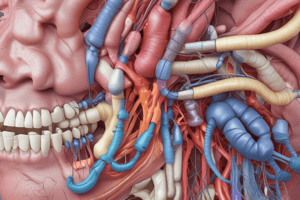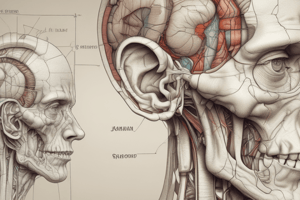Podcast
Questions and Answers
Which cranial nerve is primarily responsible for the movement of the eyes upward, medially, and downward?
Which cranial nerve is primarily responsible for the movement of the eyes upward, medially, and downward?
- III Oculomotor (correct)
- IV Trochlear
- II Optic
- VI Abducens
What is the primary function of the VII Facial nerve?
What is the primary function of the VII Facial nerve?
- Taste for the anterior 2/3 of the tongue and facial expressions (correct)
- Defecation and slowed heart rate
- Hearing and Equilibrium
- Vision
Which cranial nerve is associated with the sensation of touch in the forehead and cheek, as well as the ability to clench teeth?
Which cranial nerve is associated with the sensation of touch in the forehead and cheek, as well as the ability to clench teeth?
- V Trigeminal (correct)
- XII Hypoglossal
- IX Glossopharyngeal
- X Vagus
Which cranial nerve is involved with hearing and balance?
Which cranial nerve is involved with hearing and balance?
What is the function of the IX Glossopharyngeal nerve?
What is the function of the IX Glossopharyngeal nerve?
Which cranial nerve is primarily responsible for lateral vision?
Which cranial nerve is primarily responsible for lateral vision?
During an eye examination, which movement is tested by the superior oblique muscle?
During an eye examination, which movement is tested by the superior oblique muscle?
Which of the following is NOT assessed when inspecting the external ear and canal?
Which of the following is NOT assessed when inspecting the external ear and canal?
What does a positive whisper test indicate during an ear examination?
What does a positive whisper test indicate during an ear examination?
Which cranial nerve is responsible for the response of the pupil to light during the eye examination?
Which cranial nerve is responsible for the response of the pupil to light during the eye examination?
What is the primary function of the 2nd Left Intercostal Space during auscultation?
What is the primary function of the 2nd Left Intercostal Space during auscultation?
Which auscultation site is associated with 'Erbs point'?
Which auscultation site is associated with 'Erbs point'?
Which mnemonic helps remember the order of heart sounds during auscultation?
Which mnemonic helps remember the order of heart sounds during auscultation?
At which intercostal space would you find the Tricuspid valve sound?
At which intercostal space would you find the Tricuspid valve sound?
What is the correct auscultation site for the Aortic valve sound?
What is the correct auscultation site for the Aortic valve sound?
Which cranial nerve primarily tests for facial expressions like smiling and frowning?
Which cranial nerve primarily tests for facial expressions like smiling and frowning?
What assessment technique is utilized to evaluate the function of the Vagus nerve?
What assessment technique is utilized to evaluate the function of the Vagus nerve?
Which cranial nerve is tested for the ability to move the tongue and articulate sounds like D, L, N, and I?
Which cranial nerve is tested for the ability to move the tongue and articulate sounds like D, L, N, and I?
Which cranial nerve is responsible for controlling lateral eye movement?
Which cranial nerve is responsible for controlling lateral eye movement?
Testing the sensation of the face requires assessment of which cranial nerve?
Testing the sensation of the face requires assessment of which cranial nerve?
What function is primarily assessed by the Acoustic nerve?
What function is primarily assessed by the Acoustic nerve?
Which cranial nerve controls the muscles of the sternocleidomastoid and is assessed by shoulder shrugging?
Which cranial nerve controls the muscles of the sternocleidomastoid and is assessed by shoulder shrugging?
Which test is used to assess both the function of the Oculomotor nerve and accommodation of the pupils?
Which test is used to assess both the function of the Oculomotor nerve and accommodation of the pupils?
What should be assessed during the palpation of the respiratory system?
What should be assessed during the palpation of the respiratory system?
During auscultation, what is being checked for in the trachea?
During auscultation, what is being checked for in the trachea?
Which condition can cause deviations in the mass of the chest and possibly lead to further complications?
Which condition can cause deviations in the mass of the chest and possibly lead to further complications?
What finding indicates a normal respiratory examination?
What finding indicates a normal respiratory examination?
Which of the following is a likely cause of adventitious lung sounds such as crackles or wheezing?
Which of the following is a likely cause of adventitious lung sounds such as crackles or wheezing?
Which of these findings is typical for a patient with pneumothorax?
Which of these findings is typical for a patient with pneumothorax?
What condition would likely result in bleeding gums?
What condition would likely result in bleeding gums?
Which cranial nerve is assessed when testing the courage and swallowing reflex?
Which cranial nerve is assessed when testing the courage and swallowing reflex?
What assessment is performed to observe the movement of the chest during respiration?
What assessment is performed to observe the movement of the chest during respiration?
What is indicated by a smooth, symmetrical neck with no distension?
What is indicated by a smooth, symmetrical neck with no distension?
Which spinal abnormality is characterized by excessive outward curvature and is relevant in a respiratory examination?
Which spinal abnormality is characterized by excessive outward curvature and is relevant in a respiratory examination?
What observation would suggest a normal auscultation of the lung fields?
What observation would suggest a normal auscultation of the lung fields?
What could indicate a trachea that is not midline during examination?
What could indicate a trachea that is not midline during examination?
What finding would suggest a restrictive lung disease during physical examination?
What finding would suggest a restrictive lung disease during physical examination?
When palpating the carotid pulse, what is the expected finding?
When palpating the carotid pulse, what is the expected finding?
What does a normal range of motion at the spine during thorax inspection suggest?
What does a normal range of motion at the spine during thorax inspection suggest?
What is the primary method to assess the function of the CN II - Optic Nerve?
What is the primary method to assess the function of the CN II - Optic Nerve?
Which of the following cranial nerves is primarily involved in assessing sensation and motor function of the face?
Which of the following cranial nerves is primarily involved in assessing sensation and motor function of the face?
What does the test for PERRLA assess?
What does the test for PERRLA assess?
Which cranial nerve should be tested by rubbing fingers together in one ear while whispering in the opposite ear?
Which cranial nerve should be tested by rubbing fingers together in one ear while whispering in the opposite ear?
To test the strength of the sternocleidomastoid muscles, which cranial nerve should be assessed?
To test the strength of the sternocleidomastoid muscles, which cranial nerve should be assessed?
What is one way to assess the function of CN IX - Glossopharyngeal?
What is one way to assess the function of CN IX - Glossopharyngeal?
Which cranial nerve function is assessed by observing the patient’s tongue for symmetry and strength?
Which cranial nerve function is assessed by observing the patient’s tongue for symmetry and strength?
The ability of the patient to feel light touch on their face is primarily assessed through which cranial nerve?
The ability of the patient to feel light touch on their face is primarily assessed through which cranial nerve?
Flashcards
Olfactory Nerve Function
Olfactory Nerve Function
Tests sense of smell. Ask about any smelling difficulties.
Oculomotor Nerve Function
Oculomotor Nerve Function
Tests eye movement and pupil response. Checks eyelid elevation and 6 cardinal gaze fields.
Trigeminal Motor Function
Trigeminal Motor Function
Tests chewing muscles.
Facial Nerve Function
Facial Nerve Function
Signup and view all the flashcards
Acoustic Nerve Function
Acoustic Nerve Function
Signup and view all the flashcards
Glossopharyngeal Nerve Function
Glossopharyngeal Nerve Function
Signup and view all the flashcards
Spinal Accessory Nerve Function
Spinal Accessory Nerve Function
Signup and view all the flashcards
Hypoglossal Nerve Function
Hypoglossal Nerve Function
Signup and view all the flashcards
CN I: Olfactory Nerve
CN I: Olfactory Nerve
Signup and view all the flashcards
CN II: Optic Nerve
CN II: Optic Nerve
Signup and view all the flashcards
CN III, IV, VI: Oculomotor, Trochlear, Abducent Nerves
CN III, IV, VI: Oculomotor, Trochlear, Abducent Nerves
Signup and view all the flashcards
CN V: Trigeminal Nerve
CN V: Trigeminal Nerve
Signup and view all the flashcards
CN VII: Facial Nerve
CN VII: Facial Nerve
Signup and view all the flashcards
CN VIII: Acoustic Nerve
CN VIII: Acoustic Nerve
Signup and view all the flashcards
CN IX: Glossopharyngeal Nerve
CN IX: Glossopharyngeal Nerve
Signup and view all the flashcards
CN X: Vagus Nerve
CN X: Vagus Nerve
Signup and view all the flashcards
What is a Cranial Nerve?
What is a Cranial Nerve?
Signup and view all the flashcards
Name the cranial nerve for smell.
Name the cranial nerve for smell.
Signup and view all the flashcards
What nerve controls our eye movement?
What nerve controls our eye movement?
Signup and view all the flashcards
Name the nerve responsible for hearing and balance.
Name the nerve responsible for hearing and balance.
Signup and view all the flashcards
What nerve controls tongue movement?
What nerve controls tongue movement?
Signup and view all the flashcards
What is auscultation?
What is auscultation?
Signup and view all the flashcards
Areas of auscultation
Areas of auscultation
Signup and view all the flashcards
Where is the aortic valve sound heard?
Where is the aortic valve sound heard?
Signup and view all the flashcards
What is Erbs point?
What is Erbs point?
Signup and view all the flashcards
What is the mnemonic for remembering the auscultation sites?
What is the mnemonic for remembering the auscultation sites?
Signup and view all the flashcards
What are normal respiratory sounds?
What are normal respiratory sounds?
Signup and view all the flashcards
What does chest excursion mean?
What does chest excursion mean?
Signup and view all the flashcards
What are vesicular sounds?
What are vesicular sounds?
Signup and view all the flashcards
What is a pneumothorax?
What is a pneumothorax?
Signup and view all the flashcards
What is kyphosis?
What is kyphosis?
Signup and view all the flashcards
What is scoliosis?
What is scoliosis?
Signup and view all the flashcards
What are adventitious sounds?
What are adventitious sounds?
Signup and view all the flashcards
What are some causes of restriction lung disease?
What are some causes of restriction lung disease?
Signup and view all the flashcards
Pupillary light reflex
Pupillary light reflex
Signup and view all the flashcards
Six Cardinal Fields of Gaze
Six Cardinal Fields of Gaze
Signup and view all the flashcards
Whisper Test
Whisper Test
Signup and view all the flashcards
CN I Olfactory
CN I Olfactory
Signup and view all the flashcards
Sclera
Sclera
Signup and view all the flashcards
Pink, moist, smooth lips
Pink, moist, smooth lips
Signup and view all the flashcards
Oral mucosa: Pink, moist, smooth
Oral mucosa: Pink, moist, smooth
Signup and view all the flashcards
No caries or inflammation
No caries or inflammation
Signup and view all the flashcards
What does "No distension" mean in a JVD test?
What does "No distension" mean in a JVD test?
Signup and view all the flashcards
Auscultation: Midline- sounds harsh on expiration.
Auscultation: Midline- sounds harsh on expiration.
Signup and view all the flashcards
What indicates a healthy chest excursion?
What indicates a healthy chest excursion?
Signup and view all the flashcards




